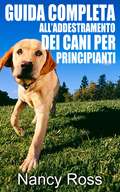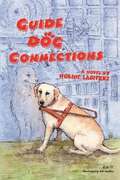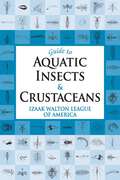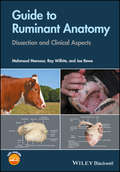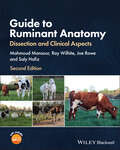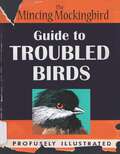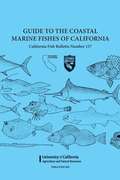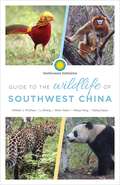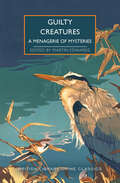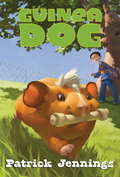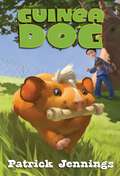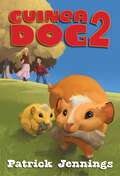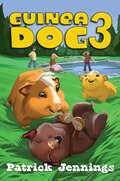- Table View
- List View
Guida completa all’addestramento dei cani per principianti
by Nancy Ross Barbara ParuttoVUOI SCOPRIRE UN MODO DAVVERO FACILE PER ADDESTRARE IL TUO CANE? Che si tratti di insegnargli dove fare i bisogni o fargli imparare alcuni comandi di base, questo libro è ciò che fa per te. Ecco cosa potrai imparare... I motivi per cui addestrare il tuo cane Come essere il capobranco Addestramento all’obbedienza Addestramento a non sporcare in casa Addestramento al trasportino Addestramento al guinzaglio Comandi di base da insegnare al cane Risolvere problemi comportamentali Molto altro ancora!!
Guidance for the Description of Animal Research in Scientific Publications
by The National Academy of SciencesA committee offers guidance to journal editors, authors, and reviewers on reporting laboratory research that involves animals in such a manner that peers can understand and use the information in their own research. The guide covers defining an optimal description of an animal study, the research animal, the research environment and study conditions, basic animal methodology, and aquatic systems. There is no index. Annotation ©2012 Book News, Inc. , Portland, OR (booknews. com)
Guide Dog Connections
by Norine LabitzkeWhat do an old Labrador from a loving family and a young Golden Retriever from a prison have in common? Moses, about to retire, doesn't want to give up his guide dog post, especially to a girl dog. He meets the new guide dog, Goldie, and is instantly suspicious, jealous and curious. Even though their backgrounds are different, they learn that they were both trained to do one thing: help a blind person. Two fifth graders, Ashley and Chloe, simultaneously develop a friendship after a rocky start. Ashley and the "in crowd" reject Chloe, because her mother's in prison. As they come to know Chloe, they accept her for who she is. Ashley's mother is blind and she and Chloe discover their lives are intricately connected. Ashley and Chloe learn about people, dogs, different kinds of blindness, the obstacles, the accomplishments, and varied careers of blind people. They learn about various kinds of working dogs. They look beyond differences and disabilities and find human qualities of love and compassion, sometimes in unexpected ways. The book tells the story of a Guide Dog's life from birth through retirement and compares being raised in a prison and a home. For grades 4-7.
Guide Dogs (Dog Heroes)
by Melissa McdanielA blind man named Omar was on the building's 71st floor when he heard the explosion. He told his guide dog, Salty, to run ahead. He wanted Salty to save himself. Instead, the brave dog stayed by Omar's side and led him through smoke and fire down 71 flights of steps. Look inside to find out more about Salty and other dog heroes who sometimes find their own lives in danger as they help their human partners find their way.
Guide Dogs for the Blind (Working Dogs)
by Howard Schroeder Phyllis Raybin EmertFrom the book jacket: Can you imagine what it would be like to cross a busy street if you were blind? You will learn how "seeing-eye" dogs are trained. In this easy to read nonfiction book students grades 2 - 4 can learn about Buddy the first Guide dog in America, about which breeds are used for guide work, about different ways the dogs are trained, and what a blind person and dog to during class. Other books in this series are available from Bookshare. There is also a chapter on guide dog instructors, costs and a glossary of useful terms. Breeds represented are Labrador retriever, Golden Retriever, and German Shepherd Dog.
Guide for the Care and use of Laboratory Animals: Eighth Edition
by National Research Council of the National AcademiesA respected resource for decades, the Guide for the Care and Use of Laboratory Animals has been updated by a committee of experts, taking into consideration input from the scientific and laboratory animal communities and the public at large. The Guide incorporates new scientific information on common laboratory animals, including aquatic species, and includes extensive references. It is organized around major components of animal use: Key concepts of animal care and use. The Guide sets the framework for the humane care and use of laboratory animals. Animal care and use program. The Guide discusses the concept of a broad Program of Animal Care and Use, including roles and responsibilities of the Institutional Official, Attending Veterinarian and the Institutional Animal Care and Use Committee. Animal environment, husbandry, and management. A chapter on this topic is now divided into sections on terrestrial and aquatic animals and provides recommendations for housing and environment, husbandry, behavioral and population management, and more. Veterinary care. The Guide discusses veterinary care and the responsibilities of the Attending Veterinarian. It includes recommendations on animal procurement and transportation, preventive medicine (including animal biosecurity), and clinical care and management. The Guide addresses distress and pain recognition and relief, and issues surrounding euthanasia. Physical plant. The Guide identifies design issues, providing construction guidelines for functional areas; considerations such as drainage, vibration and noise control, and environmental monitoring; and specialized facilities for animal housing and research needs. The Guide for the Care and Use of Laboratory Animals provides a framework for the judgments required in the management of animal facilities. This updated and expanded resource of proven value will be important to scientists and researchers, veterinarians, animal care personnel, facilities managers, institutional administrators, policy makers involved in research issues, and animal welfare advocates.
Guide to Aquatic Insects & Crustaceans
by Izaak Walton League of AmericaFully illustrated guide to identifying water-dwelling macroinvertebrates. A handy resource for anglers, students, biologists, or anyone else spending time near rivers and streams. Gives tips for distinguishing similar species and includes information for each species on behavior and role played in the ecosystem.
Guide to Canine and Feline Electrocardiography
by Ruth Willis Pedro Oliveira Antonia MavropoulouGuide to Canine and Feline Electrocardiography offers a comprehensive and readable guide to the diagnosis and treatment of abnormal heart rhythms in cats and dogs. Covers all aspects of electrocardiography, from basics to advanced concepts of interest to specialists Explains how to obtain high-quality electrocardiograms Offers expert insight and guidance on the diagnosis and treatment of simple and complex arrhythmias alike Features numerous case examples, with electrocardiograms and Holter monitor recordings Shows the characteristics of normal and abnormal heart rhythms in dogs and cats Includes access to a website with self-assessment questions and the appendices and figures from the book
Guide to Ducks and Geese
by Chuck HagnerAn easy-to-use introduction and ID guide. Includes all North American ducks and geese. With a "What to Look For" list for each species.
Guide to Ruminant Anatomy: Dissection and Clinical Aspects
by Joe Rowe Mahmoud Mansour Ray WilhiteGuide to Ruminant Anatomy: Dissection and Clinical Aspectspresents a concise, clinically relevant reference to goat and cattle anatomy, with color schematic illustrations and embalmed arterially injected prosection images for comparison. Offers 244 color images depicting goat and cattle anatomy Provides selected line drawings correlated to dissection images of embalmed arterially injected specimens Takes a practical approach, with material organized by body system within each region Demonstrates the clinical relevance of basic anatomy Poses review questions in each chapter, with answers and videos provided on a companion website
Guide to Ruminant Anatomy: Dissection and Clinical Aspects
by Thomas PasslerGuide to Ruminant Anatomy Familiarize yourself with the anatomy of ruminants and food animals with this up-to-date guide Guide to Ruminant Anatomy provides a richly illustrated guide tailored to the practical needs of veterinary clinicians. Divided for ease of use into sections representing different parts of the ruminant body, this in-depth introduction uses real dissection images to familiarize readers in detail with the internal and external anatomy of caprine, ovine, and bovine animals. It provides an outstanding demonstration of the relevance of anatomy in clinical settings. Guide to Ruminant Anatomy readers will also find: Practical clinical applications discussed by board certified clinicians in each chapter Line drawings corresponding to dissection images of embalmed specimens Learning objectives in each section, tying key concepts to clinician development A companion website featuring laboratory videos demonstrating relevant anatomy Guide to Ruminant Anatomy is an essential guide for veterinary students studying anatomy of food animals, as well as veterinary practitioners of all kinds looking for an easy-to-use reference on ruminant anatomy.
Guide to Troubled Birds
by Mockingbird The MincingA humorous, illustrated, pocket field guide describing where to find—or where to avoid—the most disturbed North American birds. The Mincing Mockingbird Guide to Troubled Birds allows anyone to quickly identify psychotic, violent or mentally unstable bird species—and provides the perfect gag gift for your bird loving (or fearing) friends and family. Throughout the book the reader will discover tales of murder, assault, mental breakdowns, obesity, drug abuse and infidelity among the birds. This guide is used and recommended by law enforcement agencies and ignored by leading ornithologists.We are only just discovering the reality of our avian adversaries, with their reptilian brains, their appetites for mayhem and the fact that they fly mostly to spite us. To ignore the information found within this volume may be at the peril of your very life.Perfect for: • White elephant gifts • Animal lover gifts • Bird lovers gift • Gag gifts • Funny gifts • Christmas gifts
Guide to the Coastal Marine Fishes of California (Fish Bulletin No. #157)
by D. J. Miller R. N. LeaThis is a comprehensive identification guide encompassing all shallow marine fishes within California waters.
Guidelines For The Care And Use Of Mammals In Neuroscience And Behavioral Research
by Committee on Guidelines for the Use of Animals in Neuroscience Behavioral Research"Guidelines for the Care and Use of Mammals in Neuroscience and Behavioral Research treats the development and evaluation of animal-use protocols as a decision-making process, not just a decision. To this end, it presents the most current, in-depth information about the best practices for animal care and use, as they pertain to the intricacies of neuroscience and behavioral research.
Guidelines For The Humane Transportation Of Research Animals
by National Research Council of the National AcademiesArranging the transportation of animals at research facilities is often an ordeal. There is a confusing patchwork of local, national, and international regulations; a perceived lack of high-quality shipping services; a dearth of science-based good practices; and a lack of biosafety standards. It’s a challenge —and an impediment to biomedical research. Guidelines for the Humane Transportation of Research Animals identifies the current problems encountered in the transportation of research animals and offers recommendations aimed at local and federal officials to rectify these problems. This book also includes a set of good practices based on the extensive body of literature on transportation of agricultural animals, universal concepts of physiology, and a scientific understanding of species-specific needs and differences. Good practices were developed by the committee to address thermal environment, space requirements, food and water requirements, social interaction, monitoring of transportation, emergency procedures, personnel training, and biosecurity. Guidelines for the Humane Transportation of Research Animals is an essential guide for all researchers, animal care technicians, facilities managers, administrators, and animal care and use committees at research institutions.
Guiding Stars: The Guide Dogs for the Blind Association
by Peter IresonA selection of writings, recollections and images chosen to convey some of the joys and anxieties, achievements and disappointments experienced by the generations of people who have either used guide dogs or helped to provide them.
Guilty Creatures: A Menagerie of Mysteries (British Library Crime Classics)
by Martin Edwards"An unusually rewarding anthology whose most dangerous species remain Homo sapiens."— Kirkus ReviewsFeline friends, canine companions and aviary associates are often the truest reflections of their owners and have played a crucial role in classic crime fiction—be they detectives, or delinquents. Martin Edwards reaches into the British Library of Crime Classics to collect mysteries featuring an animal cohort.Guilty Creatures celebrates an often-overlooked species of classic crime fiction. Since the dawn of the crime fiction genre, animals of all kinds have played a memorable part in countless mysteries, and in a variety of roles: the perpetrator, the key witness, the sleuth's trusted companion. This collection of fourteen stories corrals plots centered around cats, dogs, and insects alongside more exotic incidents involving gorillas, parakeets, and serpents—complete with a customary shoal of red herrings.The collection includes an introduction on animals in detective fiction by Martin Edwards. "From the first detective story, Edgar Allan Poe's locked room puzzle 'The Murders in the Rue Morgue' onwards, animals, birds, and insects have played a memorable part in countless mysteries, and in a wide variety of ways. Count Fosco, the brilliantly characterized villain in Wilkie Collins's The Woman in White was surrounded by "a cockatoo, two canary-birds and a whole family of white mice," while the hound of the Baskervilles famously terrorised Dartmoor in Arthur Conan Doyle's superb Sherlock Holmes novel. Since then, many crime writers have written about members of the animal kingdom."
Guinea Dog
by Patrick JenningsRufus has been dreaming of getting a dog. His best friend has one. His worst friend has one. But his dad has a few objections: They whine. They gnaw. They bark. They scratch. They beg. They drool. Rufus pays no attention when his mom offers her think-outside-the-box suggestion, because she can't be serious. She can't be. She can be. And she actually comes home with a guinea pig. And if Rufus's dad thinks dogs are a problem, he won't know what hit him when he meets the Guinea Pig that Thinks She's a Dog. She barks. She bites. She'll eat your homework.
Guinea Dog (Guinea Dog #1)
by Patrick JenningsRufus has been dreaming of getting a dog. His best friend has one. His worst friend has one. But his dad has a few objections: They whine. They gnaw. They bark. They scratch. They beg. They drool. Rufus pays no attention when his mom offers her think-outside-the-box suggestion, because she can't be serious. She can't be. She can be. And she actually comes home with a guinea pig. And if Rufus's dad thinks dogs are a problem, he won't know what hit him when he meets the Guinea Pig That Thinks She's a Dog. She barks. She bites. She'll eat your homework.
Guinea Dog 2
by Patrick JenningsWhen his classmates learn about Fido, the guinea pig that acts like a dog, they all want a piece of Rufus, her owner. But Rufus hates the attention, the demands, the "celebrity." So he decides to make Fido learn how to be an actual guinea pig. But when she goes missing, he feels terrible. Was she lost, "dognapped," or did she run away, because he no longer liked her just the way she was? Offering the same offbeat humor and pacing of the first Guinea Dog, this novel will prove to be a reader's best friend.
Guinea Dog 2
by Patrick JenningsReaders who loved Guinea Dog have been sitting, begging, and rolling over for a sequel. The beloved Patrick Jennings returns with the follow up to his award-winning and state list hogging title!When his classmates learn about Fido, the guinea pig that acts like a dog, they all want a piece of Rufus, her owner. But Rufus hates the attention, the demands, the "celebrity." So he decides to make Fido learn how to be an actual guinea pig. But when she goes missing, he feels terrible. Was she lost, "dognapped," or did she run away, because he no longer liked her just the way she was? Offering the same offbeat humor and pacing of the first Guinea Dog, this novel will prove to be a reader's best friend
Guinea Dog 2 (Guinea Dog #2)
by Patrick JenningsReaders who loved Guinea Dog have been sitting, begging, and rolling over for a sequel. The beloved Patrick Jennings returns with the follow up to his award-winning and state list hogging title! When his classmates learn about Fido, the guinea pig that acts like a dog, they all want a piece of Rufus, her owner. But Rufus hates the attention, the demands, the "celebrity." So he decides to make Fido learn how to be an actual guinea pig. But when she goes missing, he feels terrible. Was she lost, "dognapped," or did she run away, because he no longer liked her just the way she was? Offering the same offbeat humor and pacing of the first Guinea Dog, this novel will prove to be a reader's best friend.
Guinea Dog 3
by Patrick JenningsAn award-winning, hilariously funny middle-grade series about guinea pigs who act like other pets will move its author, Patrick Jennings, into the ranks of much-loved writers, such as Louis Sachar and Andrew Clements.When Rufus, Murphy, Lurena, and their pets go camping, they meet Pedro, a shy boy who seems afraid of just about everything--especially the water. One thing leads to another and the kids go into a nearby town to buy him a pet to cheer him up--a guinea pig, naturally. Yet what they bring home may look like a guinea pig, but it can swim--like an otter!Guinea Dog has appeared not only on many state lists, but on county and school district lists as well. Here are just some of its appearances: Hawaii NeNe Award Nominee, Washington State Sasquatch Award Nominee, Massachusetts Children's Book Award Honor, Florida Sunshine State Master List, Kansas Winner of the William Allen White Award, Colorado Children's Book Award Nominee, New Hampshire Great Stone Face Award Master List, and Texas's Cy-Fair Horned Toad Tales List."Short, manageable chapters; a breezy, conversational style; and indentifiable characters...make this a good choice."--Booklist"Early-chapter book readers will enjoy..."--School Library Journal"The writing is strong, the characters are a lot of fun, and the story just plain enjoyable ...There's a little something everyone can enjoy in this last Jennings number."--Betsy Bird, Fuse8Patrick's website is patrickjennings.com, or you may follow him on Twiitter @pjenningswrites.
Guinea Dog 3 (Guinea Dog #3)
by Patrick JenningsNo one could love camping more than Rufus. He and his best friend, Murphy, and their families and pets, including Fido, Rufus's famous guinea pig that acts like a dog, are planning to camp by a beautiful lake and relax and have fun. Then his mom announces that, without telling him, she has invited two kids who drive him totally crazy. Lurena brags that she is an expert on all things guinea pig. Dmitri wants Fido for his own pet—and Murphy for his best friend. This vacation is turning into a bust! Yet help is not far away. Another camper, Pedro, might prove to be an ally against Dmitri and his plots. Even better, a shirt drive from the campsite, a mysterious pet shop appears out of nowhere: Petopia. Pick up the latest installment of this award-winning, hilariously funny middle-grade series!
